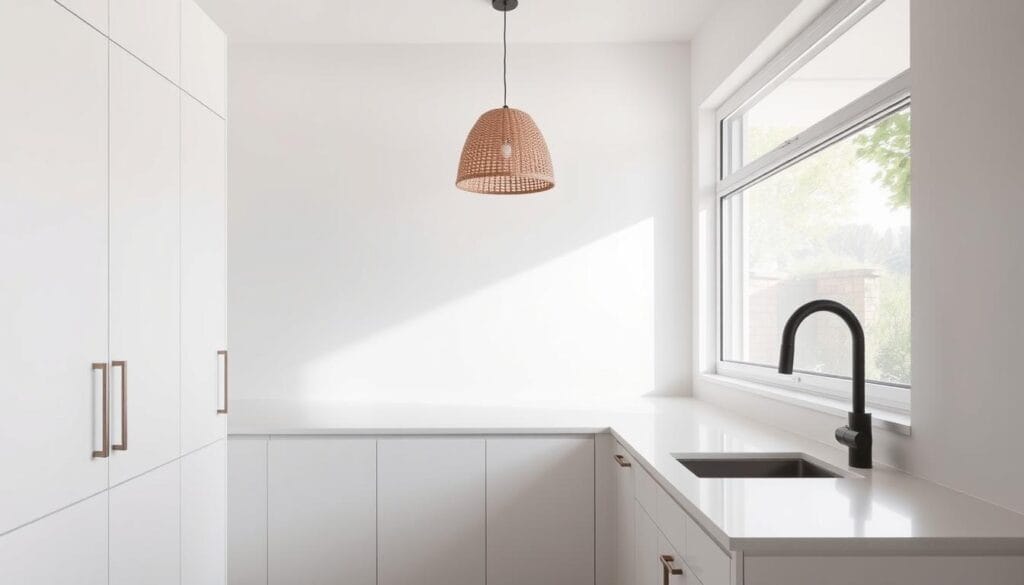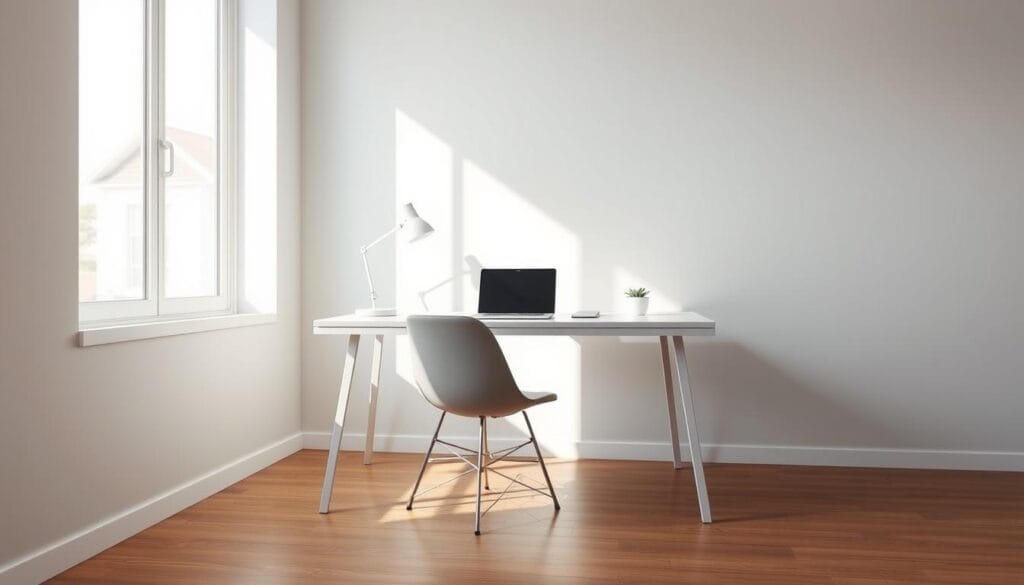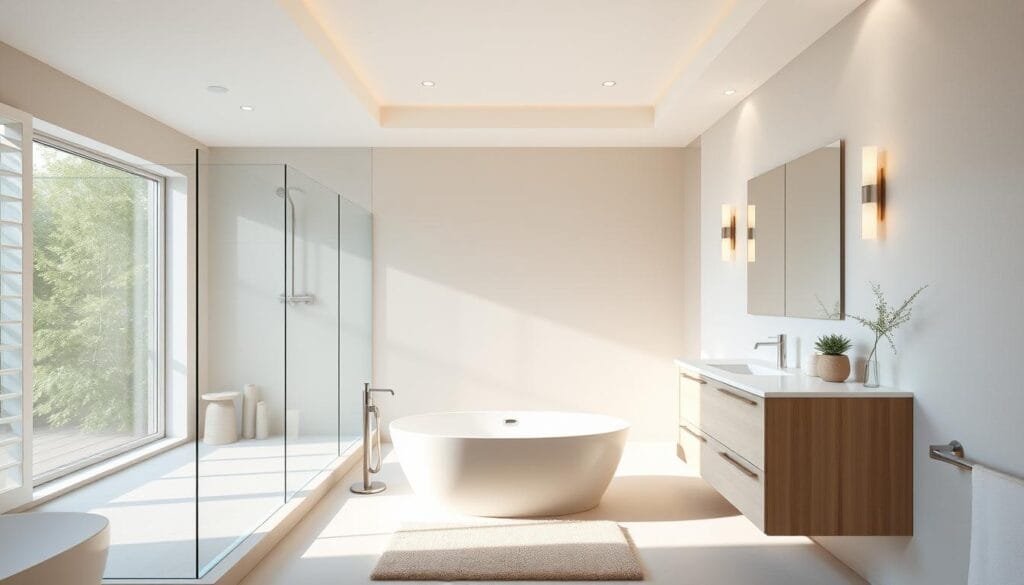Imagine your kitchen on a sunny Sunday morning. The countertops are clear, free of unneeded gadgets. Every item has its spot, neatly stored away. It’s a place where you can breathe, create, and enjoy. This is what minimalist kitchen design is all about—a perfect mix of function and beauty.
Kitchens can get messy, especially on busy mornings. That’s where minimalist design shines. By choosing simple lines and shapes, a modern minimalist kitchen looks clean and reduces mess. It finds joy in being simple.
Think of a kitchen bathed in natural light, with calming neutral colors. Picture fewer upper cabinets for less clutter and hidden storage keeping things tidy, similar to ideas inspired by modern design. Features like waterfall islands and sleek cabinetry underline minimalist design’s clean, simple look.
The choice of materials like wood and stone adds texture. Hidden appliances create a seamless look. These choices make a kitchen not just modern but timeless. Let’s look at turning your kitchen into a minimalist haven, beautiful and easy to keep up.
Ready to start this design journey? Let’s create a kitchen that truly reflects minimalist living.
Understanding Minimalist Kitchen Design Principles
Starting with minimalist design in the kitchen means learning its key ideas. It’s all about simplicity, order, and sticking to a simple color scheme. This creates a calm and tidy area. Compared to old-style designs, minimalist decor keeps things practical yet beautiful. It does this by limiting clutter and supporting a life of ease. Let’s dive into these concepts and what makes them beneficial.
The Essence of Minimalism
At its core, minimalism in the kitchen is all about keeping it simple. It uses calm colors like white, cream, gray, and beige to make a peaceful space. Adding luxury but keeping things clear with items like quality stone counters adds to the vibe. And using cabinets that blend in keeps everything looking neat, keeping to a minimalist spirit.
Benefits of a Minimalist Approach
Choosing a minimalist style in your kitchen has many pluses, not just how it looks. For one, it’s easier to clean because there’s less stuff around. Plus, having good storage like pull-out drawers and hidden cabinets helps keep clutter away. This approach means living smarter, with less mess and up to 50% fewer things on your counters. To learn more about how this works, check out this comprehensive guide.
Key Elements of Minimalist Kitchen Design
Focusing on clean lines, simple shapes, and neutral colors is key in a minimalist kitchen. These elements turn your kitchen into a calm place. Let’s look at what makes a minimalist kitchen and how to bring these ideas into your home.
Clean Lines and Simple Shapes
Minimalist kitchens love clean lines and simple shapes. Flat-panel cabinet doors make the space modern and simple. They help create a tidy environment by minimizing gaps and making surfaces flow together.
Hidden appliances are also important. Putting appliances behind custom panels makes the kitchen look sleek. Think about using touch-open doors or hidden grips for a smooth look.
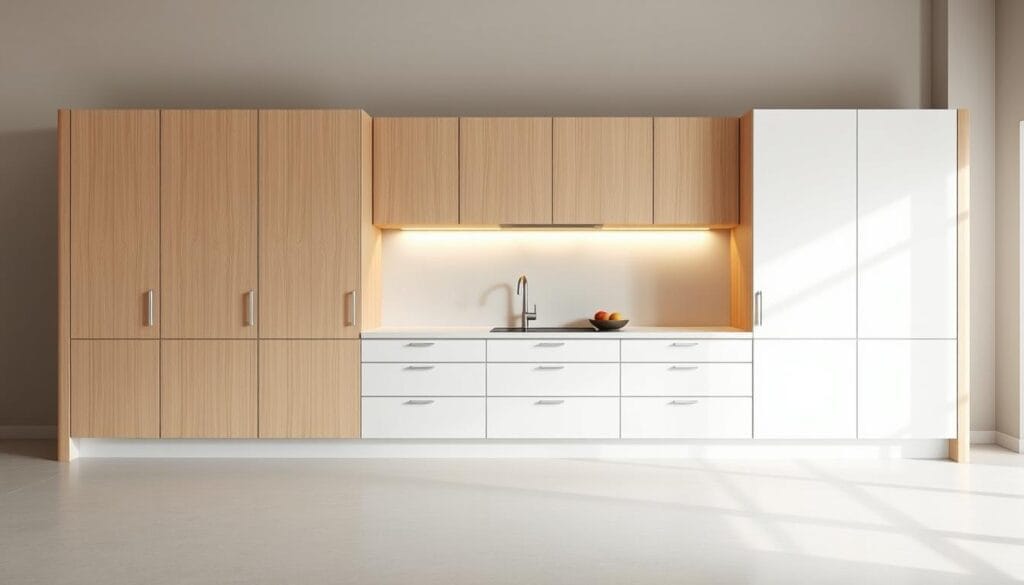
Neutral Color Palettes
A minimalist kitchen usually has colors like white, gray, or beige. These colors make the space feel calm and open. Using different shades of one color helps keep the kitchen feeling unified.
Adding a black oven to white cabinets can make the kitchen more interesting. Bringing in natural woods or textures adds warmth while keeping the minimalist feel.
Functionality Over Ornamentation
Functionality is very important in minimalist kitchens. Every part should look good and be useful. Using multi-use appliances and saving energy are good practices that also keep clutter away.
Keeping the kitchen organized is also essential. Minimalist kitchens use smart storage to stay tidy. Hidden storage and built-in appliances keep the space functional. Picking just the essential tools makes the kitchen work better and look nice.
Adding a bit of greenery with small plants keeps the kitchen fresh without ruining the minimalist style. Leaving some spaces empty is important too. It makes the kitchen feel balanced and calm.
If you’re thinking of making a minimalist kitchen, remember these tips for a functional and beautiful space. It’s not just about looking good but about improving how you use your kitchen. For more ideas, check out Design and Dwelling to see how we can bring your dream kitchen to life.
Choosing the Right Materials for a Minimalist Kitchen
Starting a minimalist kitchen renovation involves careful material choice. Materials that are both sustainable and natural support a minimalist look and are good for the planet. If you’re redoing your kitchen, consider using top-notch hardwoods like oak or maple. They are great for cabinets and floors, bringing beauty and lasting quality.
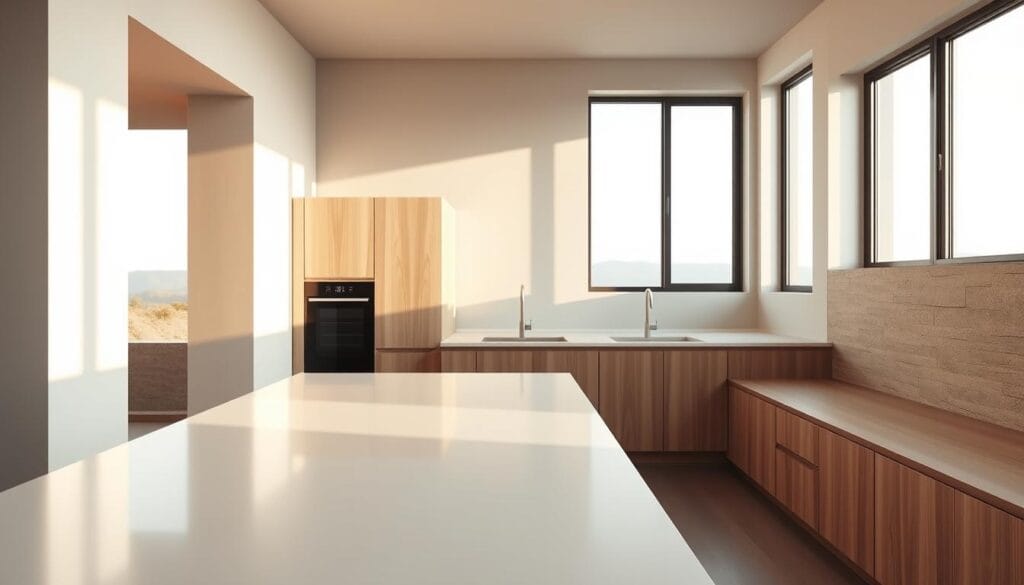
To keep a minimalist kitchen from feeling boring, mixing textures is key. Engineered quartz is perfect for counters because it resists scratches and stains and is easy to care for. Stainless steel is best for appliances and fixtures. It’s durable, looks modern, and is simple to clean.
Sustainable Material Options
Choosing materials like reclaimed wood or recycled stone is wise for minimalist kitchens. These options are environmentally friendly. Wood types such as oak and maple are especially good for cabinets and floors. They are strong and add a touch of elegance. Materials like stone, marble, and wood bring authenticity and warmth, important in minimalist design.
The Role of Textures in Design
Textures give your minimalist kitchen depth and uniqueness without making it complicated. Using polished limestone or textured wood for counters and floors can create this effect. Smooth finishes and natural elements make the space more welcoming.
| Material | Attributes | Recommendation |
|---|---|---|
| High-Quality Hardwoods (Oak/Maple) | Durable, Timeless Beauty | Cabinetry, Flooring |
| Engineered Quartz | Scratch & Stain-Resistant | Countertops |
| Stainless Steel | Modern Look, Easy to Clean | Appliances, Fixtures |
| Natural Stone/Marble | Authenticity, Warmth | Countertops, Backsplashes |
In summary, choosing the right materials and textures for a minimalist kitchen redesign makes it both practical and stylish. Thinking about sustainable woods and surfaces that feel good to touch is key to improving your kitchen’s look and feel.
Innovative Storage Solutions in Minimalist Kitchens
A clutter-free, stylish kitchen is key for modern homes. Storage solutions are crucial in preserving the look while being practical. Let’s dive into how minimalist cabinets and decor ideas can transform your kitchen space.
Smart Cabinetry Designs
Smart cabinetry is vital for a minimalist kitchen, enhancing storage efficiently. Nobilia’s unique design offers 10% extra storage, organizing items easily. Its nBox drawer system provides customizable storage with three pull-out types. These features, including hidden drawer slides and push-open options, boost both look and function. Tall cabinets utilize vertical space, ideal for large items, keeping counters clear.
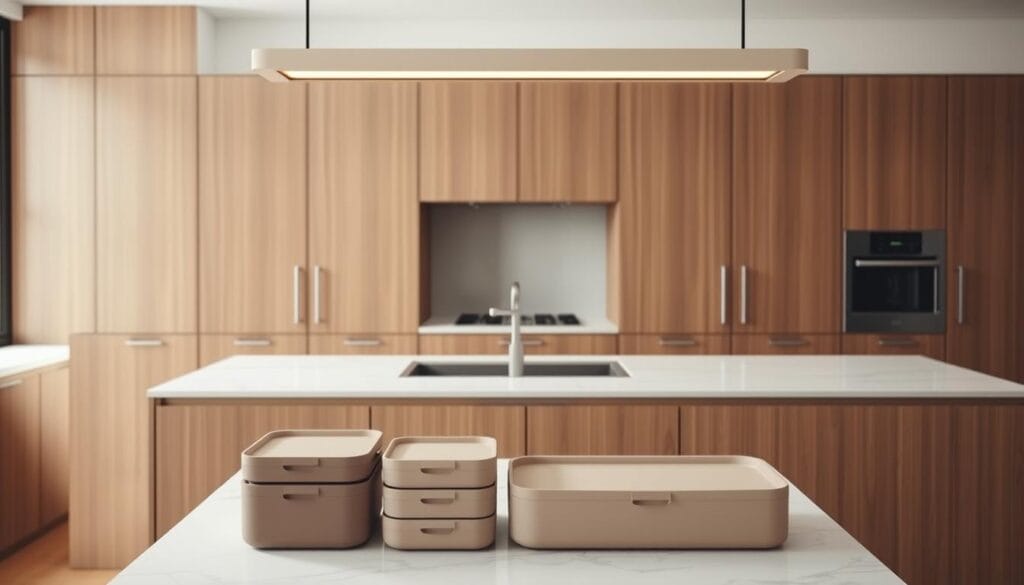
Open Shelving vs. Closed Storage
The choice between open shelving and closed storage fits your kitchen needs and style. Open shelves are great for quick access and displaying beautiful kitchenware. They keep things organized and visually pleasing. Meanwhile, closed storage hides unsightly items, giving a clean look. Soft-close technology in cabinets adds convenience and style. Wall storage also saves counter space, making cooking easier.
| Feature | Open Shelving | Closed Storage |
|---|---|---|
| Access to Items | Easy and quick | Slightly less convenient |
| Visual Appeal | Display aesthetic items | Hides clutter |
| Suitable for | Everyday essentials | Large and less attractive items |
| Maintenance | Requires regular cleaning | Less frequent cleaning needed |
Lighting Techniques for Minimalist Kitchens
Proper lighting can change any modern minimalist kitchen. It improves both how the kitchen works and looks. We must use both natural and artificial light to get the perfect minimalist feel.
Natural vs. Artificial Lighting
Natural light is key for minimalist kitchens. Adding big windows or skylights lights up the space. It also shows off the materials used and makes the kitchen seem bigger. In fact, 80% of these kitchens have them. By using more natural light, we don’t need as much artificial light. This can save energy too.
But, natural light isn’t enough by itself, especially at night. That’s when artificial light is important. Minimalist kitchens often have built-in lights like recessed lights. These fit the simple design nicely. Over 45% of these kitchens use recessed lighting. Also, 70% of homeowners like LED lights for being long-lasting and saving energy. They can cut electric bills by about 15-20%.
Statement Lighting Fixtures
Even simple designs can have bold lighting. For example, 30% of homeowners use pendant lights as a main feature in their minimalist kitchens. These lights add interest and work like art. They perfectly mix looks and usefulness.
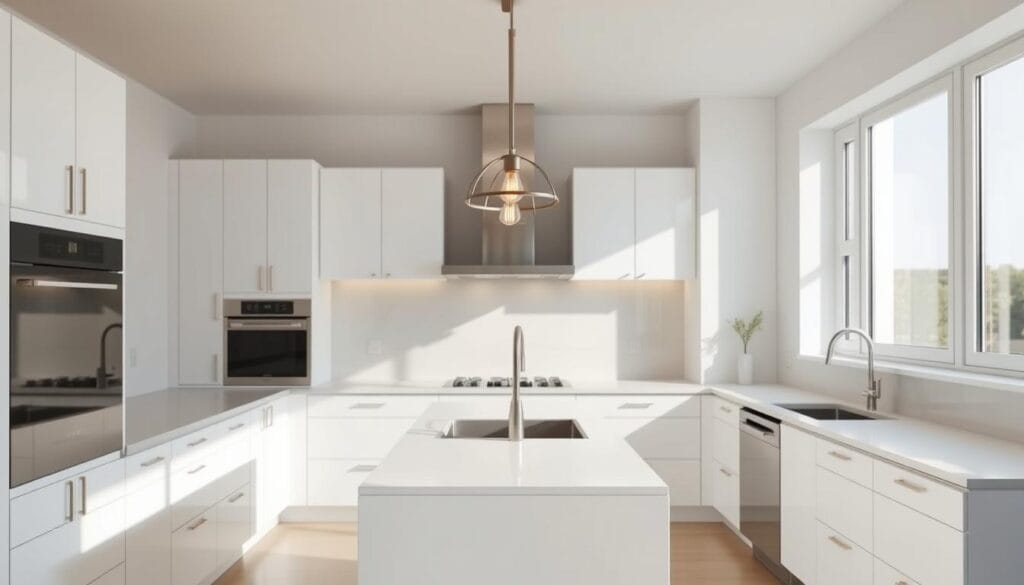
Choosing lights that fit the minimalist theme keeps the space clean and simple. Lights that aren’t too fancy keep the sleek look we want. Yet, they still give enough light for cooking and add mood.
Using both natural and artificial lights wisely changes how our kitchens feel. The right lights make them beautiful and easy to use. They stick to our love for minimalism.
Color Schemes to Enhance Minimalist Kitchens
Picking the right colors is crucial for minimalist kitchen design. The right colors make the kitchen simple, functional, and calming. You can pick from one color or add accent colors, just keep it cohesive and balanced.
Monochromatic Palette Ideas
Using one color scheme is key in minimalist kitchens. Choose white, grey, or beige to make your space look modern and united. About 70% of these kitchens stick to neutral colors. They mainly use light colors, with some dark hues and a few accents.
For example, soft sage green and white can make your kitchen feel peaceful. This combo is liked by 60% of designers. About 45% of people choose charcoal grey cabinets and wood accents for a cozy yet chic look.
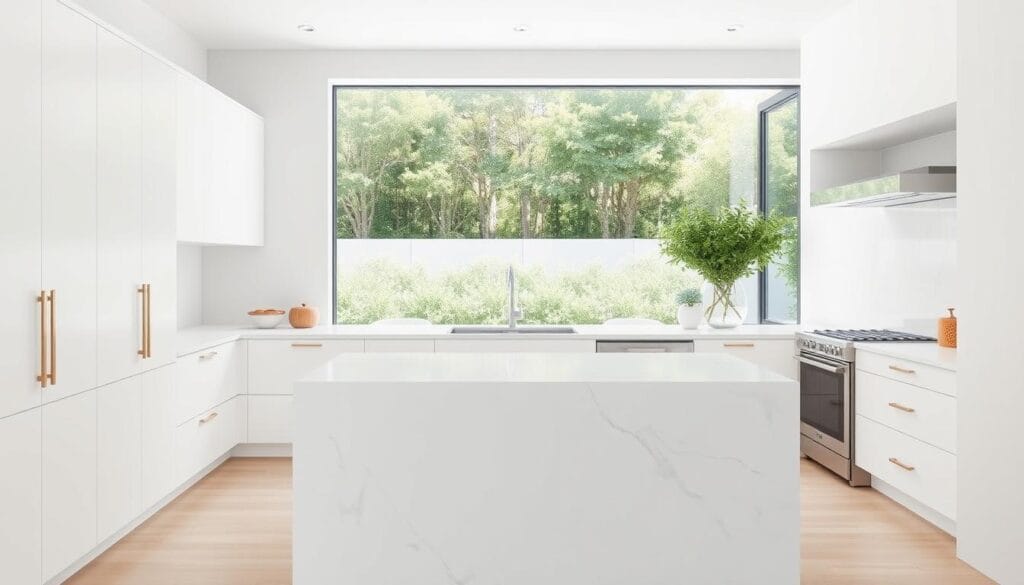
Accent Colors for Interest
If you find one color boring, add some accent colors to spice things up. Use them sparingly to keep the minimalist vibe. Earth tones like terracotta are popular for adding warmth, with 40% of designers using them.
About 70% prefer dusty blue for a calm feeling, and 50% of homeowners like black cabinets for a bold contrast. A mix of blush pink and deep navy is chosen by 25% of designers for a warm, open feel. Mint green is found in 30% of these kitchens, often with charcoal to add depth.
Wood accents are in 80% of minimalist kitchens, adding warmth and texture. It’s important to pick colors that work well with your kitchen’s light. This is advised by 90% of designers to avoid colors that clash. A well-thought-out color scheme is the key to a beautiful and functional minimalist kitchen.
Integrating Technology in Minimalist Kitchen Design
Adding technology to your minimalist kitchen makes it look better and work smarter. By getting smart appliances like advanced ovens or integrated dishwashers, you up your kitchen’s efficiency. You also keep that clean, simple look that’s key to a minimalist space. These smart upgrades help keep your kitchen tidy and stylish.
Smart Appliances for Efficiency
Smart appliances add fantastic benefits to your kitchen. Devices like smart fridges and ovens can be controlled from afar and set to run on schedules. This makes your kitchen more convenient and efficient. Smart ovens can use less materials by up to 10% and cut down on energy by 28%. This shows how a minimalist kitchen remodel is also good for our planet. Smart fridges help save energy by changing their temperature based on how full they are.
Streamlined Kitchen Gadgets
Simple yet high-functioning gadgets are key to a great minimalist kitchen. Choose devices that do more but take up less room and fit with minimalist style. Smart cabinets with built-in sensors check the temperature and humidity to keep food fresh. Plus, being able to control appliances and lights by voice makes cooking easier. It improves how your kitchen works. These smart changes not only make your kitchen look and feel better but also keep it free of mess.
Design Tips for Small Minimalist Kitchens
When creating a small minimalist kitchen, it’s key to use every inch wisely but still keep it stylish. Using smart designs and furniture that has more than one use, you get a kitchen that looks good and works well. We’ll look at some smart ways to do this.
Maximizing Space with Smart Layouts
Making the most of your kitchen’s layout makes a small space more useful. Think about using galley or L-shapes to keep things flowing and cut down on moving around too much. For example, having 48 to 60 inches of continuous counter space mixes well the need for function and storage. Also, using shallower upper cabinets, about 12 to 16 inches deep, gives you more storage without crowding the kitchen.
Using the same material for countertops and backsplashes makes the kitchen look bigger by creating a seamless look. Adding lights under cabinets isn’t just practical for cooking; it also brings a modern touch. This makes your kitchen’s minimalist style even more inviting.
Multi-Functional Furniture Choices
Choosing furniture that has more than one purpose is a must in a tight kitchen space. A breakfast bar, for instance, can give you more room to work and a place to eat in tight areas. Picking built-in handles or ones that don’t stick out can also help save space, making everything look neater.
Opting for appliances that blend into the cabinetry and sleek, minimal handles or no handles at all keeps things looking tidy. Think about using clever organizers and sliding shelves inside cabinets to make getting to things easier. This approach keeps your kitchen’s storage neat and your style on point.
Even with a small kitchen, you don’t have to give up on looking good or being functional. By choosing the right layouts and versatile furniture, you can have a beautiful minimalist kitchen that meets all your needs.
Balancing Aesthetics and Functionality
To get the right mix in a modern minimalist kitchen, looks and practicality are key. It’s important to choose things that look good and are useful. For example, good countertops and neat cabinets can make the kitchen look better and work smoother.
Prioritizing Essential Features
Planning a minimalist kitchen remodel means picking main items that are both stylish and functional. Appliances like Whirlpool dishwashers show it’s possible to care about both looks and how well things work. Getting the kitchen layout right, like L or U shapes, can make everyday jobs easier and keep your kitchen looking neat.
Using appliances that blend into the cabinets keeps things looking tidy. This trick hides big appliances, making the space feel more peaceful and organized.
Avoiding Clutter in Design
It’s important to keep a modern minimalist kitchen free from mess. Use smart storage to keep things you don’t need out of sight but have what you use often close by. Choose cabinets that have sneaky storage spots or shelves under the counter. This way, your kitchen looks clean and welcoming.
Less clutter also makes the kitchen more enjoyable to use. The move towards simpler kitchen designs has made open-concept spaces more popular. These designs help the kitchen flow better and use space wisely.
| Essential Features | Benefits | Examples |
|---|---|---|
| High-quality Countertops | Enhances durability and appearance | Quartz, Granite |
| Streamlined Cabinetry | Maximizes space and aesthetic appeal | Flat-panel, Handleless designs |
| Efficient Layouts | Improves workflow by up to 25% | L-shaped, U-shaped kitchens |
| Integrated Appliances | Enhances visual continuity | Refrigerators, Dishwashers |
| Smart Storage Solutions | Prevents clutter, keeps essentials accessible | Hidden compartments, Under-counter shelving |
Examples of Stunning Minimalist Kitchens
Minimalist kitchens have a kind of magic to them. They focus on clean lines and open spaces to make cooking peaceful and efficient. Let’s look at some great examples from famous designers and real kitchen makeovers that show how cool and versatile these kitchens can be.
Inspiring Designs from Influential Designers
Karen Smuland is an interior designer who loves mixing Scandinavian-modern styles with minimalism. She often uses big folding glass doors to let in lots of light and connect the inside with the outside. Her kitchens look extra sleek thanks to simple yet high-quality cabinets, like those from Keystone Millworks.
Using materials like Danby marble and quartzite is another hot trend. These materials are not only tough but also look fancy with their smooth finishes and patterns. They help make minimalist kitchens look classy. Designers also add natural touches with wood and stone to make the kitchen feel more connected to the outdoors.
Real-Life Minimalist Kitchen Transformations
Turning old kitchens into minimalist marvels shows how great this design style is. From 2019 to 2023, the interest in minimalist kitchens jumped by 60%. Things like built-in appliances keep the look neat, while top-notch items such as Wolf ranges and Blanco sinks ensure the kitchen is still practical.
Changing up how storage works is also key. For instance, open shelves, now in 40% of minimalist kitchens, mix looks with usefulness well. The minimalist island is another favorite, being both a place to prepare food and a spot to hang out. These changes show that the right design can turn any kitchen into a calming and welcoming space.

